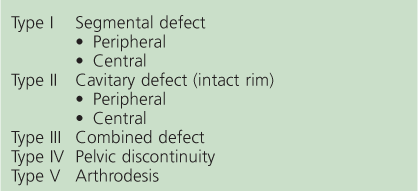Acetabular Reconstruction
Classification of Bone Defects and Treatment Options
Geoffrey Wright and Wayne G. Paprosky
Key Points
Introduction
Over the past decade, improvements in technology and surgical technique have made acetabular revision more successful and straightforward. The main goals of acetabular revision are (1) to extract failed implants with minimal bone and soft tissue damage, (2) to implant new components that provide long-term pain relief and good function, and (3) to manage bone deficiencies effectively and if possible restore bone stock.
The location and degree of acetabular bone loss can be predicted with the use of preoperative radiographs. New instruments and techniques have made removal of existing components easier. During surgery, stable implant fixation is required to obtain a good long-term clinical result. Restoring the optimal position of the acetabulum is important for providing the highest likelihood of hip stability. These factors must be addressed in the planning process of the reconstruction and can be completed in such a way that the likelihood of success is optimized.
Classification systems are used throughout orthopedics, and reconstructive surgery is no different. The ideal classification system should be simple to use and should have excellent intraobserver and interobserver reliability and validity. It should provide an accurate enough description to facilitate communication between providers, assist with preoperative evaluation, allow for determination of the most appropriate treatment options, and predict outcomes after surgery. Unfortunately, such an ideal classification system rarely exists.
This chapter will discuss the two most popular classification systems used to describe acetabular bone defects. It will review how the type of defect as determined from preoperative radiographs, the author’s approach to complicated cases, and the different treatment options available for acetabular reconstruction.
Indications/Contraindications
The decision to proceed with revision hip surgery is the endpoint of a complex decision-making process involving the patient and the surgeon. It should consider the severity of the patient’s symptoms, along with the patient’s function, disability, and general health, as well as the surgeon’s experience. However, revision hip arthroplasty usually is not indicated unless a specific problem is identified that can be surgically corrected.
Indications for acetabular revision include symptomatic aseptic loosening, failure of fixation, infection, wear, osteolysis, and instability. Revision may be indicated for an asymptomatic patient who has progressive osteolysis, severe wear, or bone loss that could compromise a future reconstruction. Historically, the most common indication for acetabular revision has been loosening of the acetabular component. However, Bozic and associates, using the Healthcare Cost and Utilization Project Nationwide Inpatient Sample database, recently found that the most common cause of revision hip surgery was instability or dislocation (22.5%).1 Mechanical loosening and infection were next in frequency at 19.7% and 14.8%, respectively. Instability or dislocation was the most common cause of an isolated acetabular revision (33%), and mechanical loosening was the second most common indication (24%). In this study, 54% of all cases required revision of the acetabulum.
Contraindications for revision of the acetabular component include severe bone loss precluding allograft fixation or implant fixation, uncontrolled infection, and medical comorbidities that preclude surgery. In these patients, nonsurgical treatment such as activity modification, ambulatory aids, and oral analgesics may be appropriate.
Classification Systems
AAOS Classification
The American Academy of Orthopaedic Surgeons (AAOS) classification of bone defects, as described by D’Antonio and associates, identifies the pattern and location of bone loss but does not quantify the defect (Box 89-1).2,3 This system, which was developed by evaluating 83 AP and lateral hip radiographs and comparing results intraoperatively, is probably the most commonly used classification in the literature. It is based on two basic categories: segmental and cavitary defects. A segmental defect (type I) is defined as complete loss of bone in the hemisphere of the acetabulum, peripherally or centrally. A central segmental defect involves loss of the medial wall of the acetabulum. A cavitary deficiency (type II) is defined as volumetric bony loss of the acetabulum with an intact rim. These defects can occur peripherally or centrally. Medial cavitary defects involve loss of bone centrally with an intact medial wall, as in most cases of protrusio. The peripheral defects in types I and II are further divided by anatomic position: medial, superior, anterior, or posterior. Combined segmental and cavitary defects (type III) occur frequently. These include defects due to a failed, migrated endoprosthesis and those defects seen in developmental dysplasia.
Pelvic discontinuity (type IV) is an unusual condition in which the superior pelvis and the inferior pelvis are separated. Typically, this occurs through a transverse acetabular fracture through weak and deficient bone. Identifying features on preoperative radiographs include a visible fracture line through the anterior and posterior columns, a break in Kohler’s line such that the superior pelvis and the inferior pelvis are offset relative to one another, and rotation of the inferior aspect of the hemipelvis relative to the superior aspect, which is often seen as asymmetry of the obturator rings.4
Arthrodesis is considered the final type of acetabular defect (type V) in this classification. Although this classification does define acetabular defects, its major flaw as a classification system is that it does not address the management of these defects.
Paprosky Classification
The Paprosky classification system is based on the severity of bone loss and on the ability to obtain cementless fixation for a given bone loss pattern.5–7 It was initially developed by evaluating the AP pelvis radiograph and comparing this information with intraoperative findings. The Paprosky classification system was designed to provide guidance on when cementless components are appropriate and when other techniques should be used. The key to this classification is determining the ability of the remaining host bone to provide initial stability to a hemispherical cementless acetabular component until ingrowth occurs. Intraoperative decisions are based on findings when trial components are used; however, intraoperative findings can often be predicted by the preoperative AP radiograph of the pelvis when this classification system is used.
Careful interpretation of the AP radiograph can predict the type of defect and can allow the surgeon to plan for the acetabular reconstruction. Four criteria are used to assess the preoperative radiograph: (1) superior migration of the hip center, (2) ischial osteolysis, (3) teardrop osteolysis, and (4) position of the implant relative to Kohler’s line (Table 89-1).
Table 89-1
Paprosky Classification of Acetabular Defects

Modified from Paprosky WG, Perona PG, Lawrence JM: Acetabular defect classification and surgical reconstruction in revision arthroplasty: a 6-year follow-up evaluation. J Arthroplasty 9:34, 1994.
Superior migration of the hip center represents bone loss in the acetabular dome involving the anterior and posterior columns. Superior and medial migration indicates greater involvement of the anterior column. Superior and lateral migration indicates greater involvement of the posterior column. The amount of superior migration is measured as the distance in millimeters (adjusted for magnification) relative to the superior obturator line, or a line drawn from the top of each obturator foramen.
Ischial osteolysis indicates bone loss from the inferior aspect of the posterior column, including the posterior wall. The amount of ischial osteolysis is quantified by measuring the distance (adjusted for magnification) from the most inferior extent of the lytic area to the superior obturator line. Mild ischial osteolysis is defined as less than 7 mm, and severe ischial osteolysis is defined as greater than 15 mm.
Teardrop osteolysis indicates bone loss from the inferior and medial aspects of the acetabulum, including the inferior aspect of the anterior column, the lateral aspect of the pubis, and the medial wall. Moderate osteolysis is defined as partial destruction of the teardrop with maintenance of the medial limb of the teardrop. Severe involvement is defined as complete obliteration of the teardrop.
Medial migration of the component relative to Kohler’s line represents a deficiency of the anterior column. Kohler’s line, or the ilioischial line, is defined as a line connecting the most lateral aspect of the pelvic brim and the most lateral aspect of the obturator foramen on an anteroposterior radiograph of the pelvis. The medial aspect of the implant is lateral to Kohler’s line with grade 1 migration and medial to the line with grade 3 migration. With grade 2 migration, migration to Kohler’s line or slight remodeling of the iliopubic and ilioischial lines occurs without a break in continuity.
With a Paprosky type 1 defect, minimal bone loss is noted (Fig. 89-1). The acetabular rim and walls are intact and supportive without distortion. The acetabulum is hemispherical, and there may be small focal areas of contained bone loss. The anterior and posterior columns are intact. The preoperative radiograph shows no superior migration of the component, no evidence of osteolysis in the ischium or teardrop, and grade 1 medial migration (Kohler’s line has not been violated). A hemispherical cementless implant is almost completely supported by native bone; however, a large cup may be required. Full inherent stability is achieved, and particulate grafting can be used to fill the minor areas of bone loss.

Figure 89-1 Type 1 acetabular defect. The rim is intact and the columns are fully supportive of a hemispherical component. Only localized bone lysis is noted. (Redrawn from Paprosky WG, Perona PG, Lawrence JM: Acetabular defect classification and surgical reconstruction in revision arthroplasty: a 6-year follow-up evaluation. J Arthroplasty 9:34, 1994.)
In a type 2 defect, the acetabular rim and walls are distorted, but the host bone is adequate to support a cementless acetabular component. The anterior and posterior columns remain intact and supportive. On the preoperative radiograph of a type 2 defect, superior migration of the hip center is less than 3 cm from the superior obturator line, osteolysis of the ischium is mild (<7 mm distal to the obturator line), and osteolysis of the teardrop is not substantial. At least 50% of the surface area of the component is in contact with host bone for potential ingrowth, and good mechanical support can be provided entirely by host bone. The trial component has full inherent stability; however, the hip center may be elevated as much as 1.5 cm to achieve superior contact and support.
Type 2 defects are subdivided into types A, B, and C, according to the bone loss pattern. Type 2A defects are oval enlargements of the acetabulum caused by superior bone lysis; however, the superior rim of the acetabulum is intact (Fig. 89-2). Migration of the component into a cavitary defect is evident medial to a thinned superior rim and is directed superior or superior medial. This migration is less than 2 cm. In most patients, the defect can be treated with particulate allograft because the remaining superior rim provides a buttress for containment of the allograft.
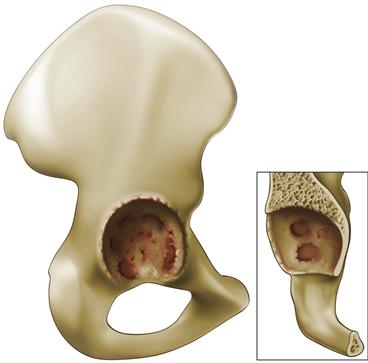
Figure 89-2 Type 2A acetabular defect. The rim remains intact; however, it is enlarged superiorly to create an oval. (Redrawn from Paprosky WG, Perona PG, Lawrence JM: Acetabular defect classification and surgical reconstruction in revision arthroplasty: a 6-year follow-up evaluation. J Arthroplasty 9:35, 1994.)
In a type 2B defect, the superior acetabular rim is missing (Fig. 89-3). Usually, less than one third of the circumference of the superior rim is deficient. This defect is not contained. The remaining anterior and posterior rims and columns are supportive of an implant. Migration of the component occurs superior and lateral because the acetabular rim is deficient. Most reconstructions are done without grafting of the segmental defect because stability can be achieved through the remaining columns. Occasionally, an allograft can be used to restore bone stock; however, it is not supportive of the implant.
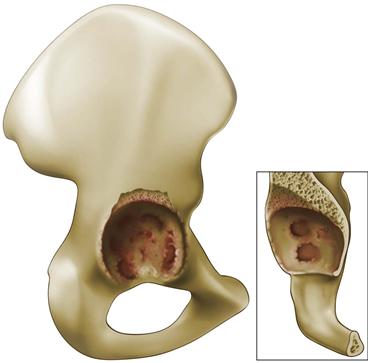
Figure 89-3 Type 2B acetabular defect. The superior rim is absent; however, the column remains fully supportive. (Redrawn from Paprosky WG, Perona PG, Lawrence JM: Acetabular defect classification and surgical reconstruction in revision arthroplasty: a 6-year follow-up evaluation. J Arthroplasty 9:36, 1994).
Type 2C defects (Fig. 89-4A and B) have a medial wall defect and migration of the acetabular component medial to the Kohler line. The rim of the acetabulum is intact and will support a hemispherical component. Reconstruction of these defects is similar to the treatment of protrusio acetabuli in the setting of a primary arthroplasty. Sequentially larger reamers are used until the acetabular rim is engaged. Particulate bone graft can be placed medially to lateralize the hip center of rotation back to its anatomic position.
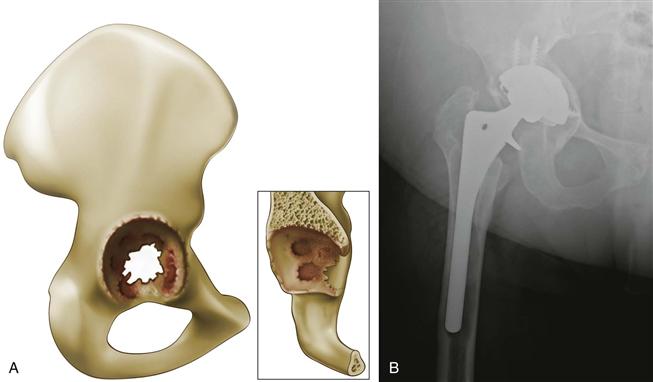
Figure 89-4 A, Type 2C acetabular defect. The rim is enlarged and the medial wall is destroyed. The teardrop may be obliterated as well.
(Redrawn from Paprosky WG, Perona PG, Lawrence JM: Acetabular defect classification and surgical reconstruction in revision arthroplasty: a 6-year follow-up evaluation. J Arthroplasty 9:37, 1994.)
B, Radiograph demonstrating a Type 2C acetabular defect. The teardrop is obliterated and the component has migrated medially past Kohler’s line.
In Paprosky type 3 defects, major acetabular bone loss has occurred. The acetabular rim and walls are compromised, and the anterior and posterior columns are nonsupportive. The remaining acetabular rim will not provide adequate initial component stability to achieve reliable biological fixation; therefore the trial implant lacks full intrinsic stability. The acetabular component has migrated proximally more than 2 cm. These defects are subdivided into two types.
Type 3A defects (Fig. 89-5A and B) involve more than one third but not more than one half of the circumference of the acetabular rim. The rim defect is usually located between the 10 o’clock and 2 o’clock positions. The medial wall of the acetabulum is present; therefore migration of the acetabular component is superolateral. Typically, the acetabular component has migrated more than 2 cm superiorly. Preoperative radiographs show superior and lateral migration of the component greater than 3 cm above the obturator line (with adjustment for magnification). Ischial lysis is mild to moderate, extending less than 15 mm inferior to the obturator line. Partial destruction of the teardrop is seen, but the medial limb usually is still present. The component is even with or lateral to Kohler’s line, and the ilioischial and iliopubic lines are intact. Enough host bone is in contact with the ingrowth surface of a hemispherical component to attain durable biological fixation (meaning that more than 50% of the surface area of the cementless cup is in contact with host bone). However, the trial components are only partially stable, and support of the implant with a structural augment or allograft is necessary in the short term to provide initial stability.
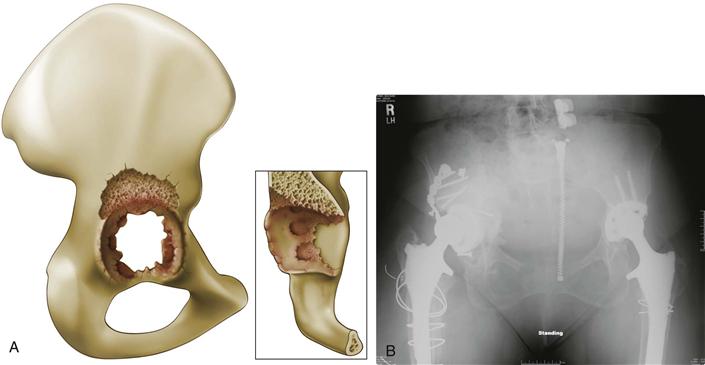
Figure 89-5 A, Type 3A acetabular defect. Bone loss along the superior rim and dome of the acetabulum. The medial teardrop is still present.
(Redrawn from Paprosky WG, Perona PG, Lawrence JM: Acetabular defect classification and surgical reconstruction in revision arthroplasty: a 6-year follow-up evaluation. J Arthroplasty 9:38, 1994.)
B, The right hip demonstrates a type 3A defect with superolateral migration of the acetabular component. The acetabular component has eroded superiorly and shifted to a vertical position. The left hip demonstrates placement of the acetabular component with a high hip center.
Type 3B defects (Fig. 89-6A and B) involve more than half of the circumference of the acetabular rim, usually extending from the 9 o’clock to the 5 o’clock position. The failed acetabular component migrates superiorly and medially because the medial wall has been destroyed. Patients with a type 3B defect are at high risk for pelvic discontinuity; this possibility must be thoroughly evaluated at the time of reconstruction. Preoperative radiographs often show severe ischial osteolysis, complete destruction of the teardrop, migration medial to Kohler’s line, and migration greater than 3 cm superior to the obturator line. Less than 40% of the ingrowth surface of the acetabular component is in contact with host bone. Inherent stability is not achievable with a trial implant. Alternative techniques are often required with these defects.
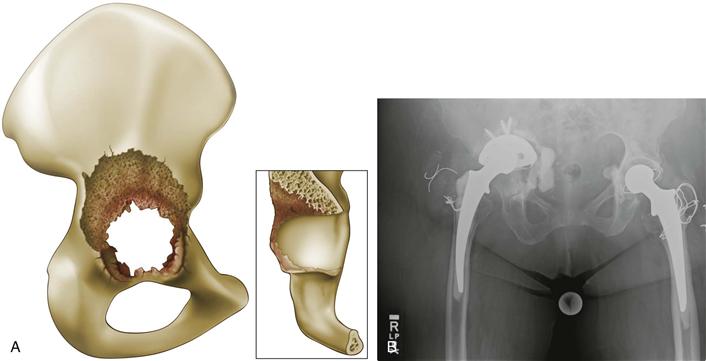
Figure 89-6 A, Type 3B acetabular defect. Complete obliteration of the medial teardrop and severe lysis. Columns are not supportive.
(Redrawn from Paprosky WG, Perona PG, Lawrence JM: Acetabular defect classification and surgical reconstruction in revision arthroplasty: a 6-year follow-up evaluation. J Arthroplasty 9:39, 1994.)
B, The right hip shows a type 3B defect with superomedial migration. The medial wall is destroyed with subsequent migration of the cup and cement into the pelvis. Severe bone loss is evident.
Reliability and Validity of the Classification Systems
Any classification system must undergo validity and reliability testing to be universally accepted. In Paprosky’s original paper, 92.5% agreement was reported between preoperative and intraoperative assessment or an assessment of the validity of the system.6 Gozzard and coworkers evaluated both of the discussed classification systems by having two orthopedic consultants and two orthopedic registrars examine 25 radiographs on two separate occasions.8 The validity of the Paprosky system, or the comparison between preoperative and intraoperative findings, was found to be good. The reliability of a system is defined as its ability to grade a given degree of bone stock loss in a consistent manner. Intraobserver reliability ranged from poor to good, depending on the experience of the observer, with the registrars having higher scores. Interobserver agreement was moderate in both classification systems.
In a separate study evaluating the AAOS and Paprosky systems, Campbell examined interobserver and intraobserver reliability for 33 hips needing revision hip arthroplasty.9 The originators of each system—three expert orthopedic surgeons and three senior residents—reviewed the films on two separate occasions at a minimum of 2 weeks apart. Overall reliability was poor for both systems. Intraobserver reliability of the originators was moderate for both, with the Paprosky classification being slightly more reliable. However, intraobserver reliability among orthopedic surgeons and residents was poor. Interobserver reliability was poor for both. Although these studies show that neither of these classification systems is perfect, both agree that some form of classification should be used to facilitate communicate between surgeons and to compare outcomes.
Preoperative Planning
Preoperative planning is a critical aspect of any reconstructive hip surgery but is particularly important in revision surgery. The surgeon must anticipate instrument, bone graft, and implant requirements for the surgery, as well as which reconstructive options may be needed, based on what may be found intraoperatively.
A complete history and physical examination should be completed, and medical clearance should be obtained, before revision acetabular surgery is performed. These procedures can take a long time and can result in significant blood loss, especially if the femoral component is being removed; therefore all of the patient’s existing medical conditions should be well controlled before surgery is begun. The patient should be aware of potential medical and surgical complications, and realistic goals should be discussed with the patient preoperatively. Discussion should include information on postoperative weight-bearing status and limitations, along with long-term outcome expectations.
Every attempt should be made to identify the cause or causes of the implant failure. The type of pain is important in that patients with start-up pain usually have loose components, and those with continuous unrelenting pain may be more likely to have an ongoing infection. The preoperative status of the muscles and neurovascular structures should be identified, specifically the function of the hip abductors. In patients with deficient abductors, larger femoral heads or constraint in the acetabular construct may be required.
Every patient undergoing revision surgery should be screened for infection with at least an erythrocyte sedimentation rate and C-reactive protein. The erythrocyte sedimentation rate should be less than 30 mm/hr and the C-reactive protein less than 10 mg/L. If these values are elevated or inconclusive, aspiration of the joint should be performed because treatment for an infected prosthesis is different from treatment for other events leading to revision arthroplasty.
Standard preoperative radiographs should include an anteroposterior pelvis film, an anteroposterior hip film, a lateral radiograph of the hip, and a shoot-through lateral radiograph. The shoot-through lateral is particularly helpful for evaluating the posterior column, which is often obscured by the cup on other films. Judet oblique pelvic views can be helpful if pelvic discontinuity is suspected. Although not required, three-dimensional imaging such as computed tomography (CT) scans may be helpful in accurately determining the pattern of the acetabular defect. CT scans are probably most helpful in patients with significant medial migration of the acetabular component when used to evaluate the proximity of neurovascular structures.
Algorithmic Approach
The authors’ approach to revision of the acetabulum is shown in the accompanying chart (Fig. 89-7). Although this is not all encompassing, it does provide an excellent guide for approaching these difficult cases. Currently, we use a posterolateral approach to the hip for all acetabular revisions. Other approaches can be used, depending on the severity of the revision and the surgeon’s experience. Careful evaluation of the preoperative radiographs is essential in determining how to proceed with the operation.
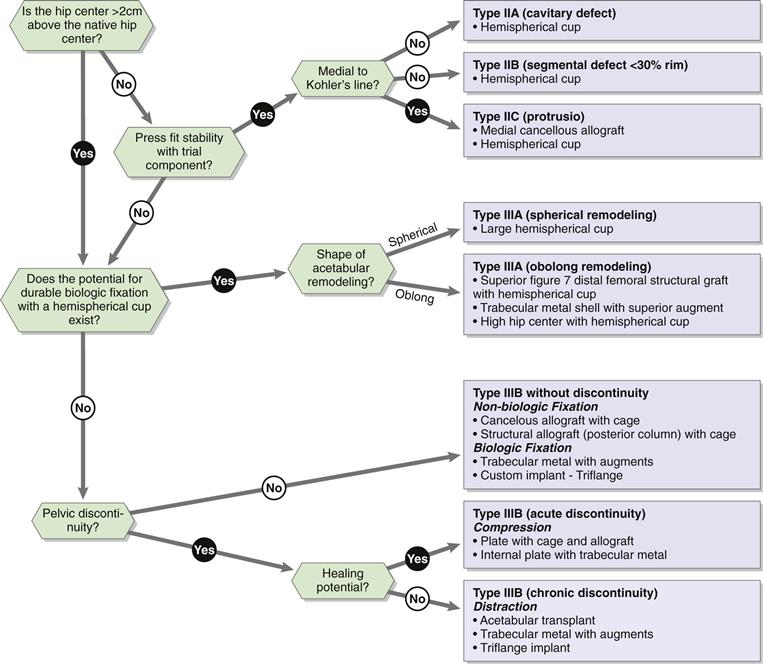
Figure 89-7 Algorithmic approach to acetabular reconstruction. (Redrawn from Sporer SM, Paprosky WG, O’Rourke MR: Managing bone loss in acetabular revision. Instr Course Lect 55:290, 2006.)
Stay updated, free articles. Join our Telegram channel

Full access? Get Clinical Tree


